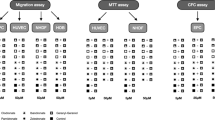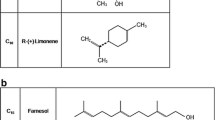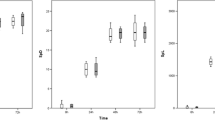Abstract
Objectives
Geranylgeraniol (GGOH) has been reported as a potential treatment option for bisphosphonate-associated osteonecrosis of the jaws (BP-ONJ). The aim of this study was to analyze the effects of GGOH on endothelial progenitor cells (EPC) after bisphosphonate treatment in vitro.
Materials and methods
EPC were incubated with different nitrogen (N-BPs: ibandronate, pamidronate, zoledronate) and a non-nitrogen-containing bisphosphonates (NN-BP: clodronate) with and without GGOH. Cell viability was measured by MTT and PrestoBlue assay. Migration ability was analyzed with a Boyden and Scratch assay. Apoptosis rates were determined by colony-forming, Tunel and ToxiLight assays.
Results
Negative effects of N-BPs on EPC were shown in all tests without GGOH. The substitution of GGOH demonstrated significantly increased cell viability (MTT: p each N-BP ≤0.004; PrestoBlue: p each N-BP <0.001) and migration ability (Boyden: p each N-BP <0.001; Scratch: p each N-BP <0.001). Concerning the apoptosis rates, increased EPC colony densities (p each N-BP ≤0.009), decreased numbers of apoptotic cells in the Tunel assay (p each N-BP <0.001), and a decreased adenylate kinase release in the ToxiLight assay (p each N-BP ≤0.03) were observed. For the clodronate-treated cells, no significant differences could be detected with or without GGOH in any assay (p each N-BP/NN-BP >0.05).
Conclusions
GGOH cell treatment reversed the negative effects of bisphosphonates on EPC.
Clinical relevance
These findings support the hypothesis that systemic or local GGOH treatment might lead to new therapeutic strategies for BP-ONJ.







Similar content being viewed by others
References
Walter C, Sagheb K, Bitzer J, Rahimi-Nedjat R, Taylor KJ (2014) Analysis of reasons for osteonecrosis of the jaws. Clin Oral Investig [Epub ahead of print]
Pabst AM, Ziebart T, Koch FP, Taylor KY, Al-Nawas B, Walter C (2012) The influence of bisphosphonates on viability, migration, and apoptosis of human oral keratinocytes—in vitro study. Clin Oral Investig 16:87–93
Hagelauer N, Pabst AM, Ziebart T, Ulbrich H, Walter C (2014) In vitro effects of bisphosphonates on chemotaxis, phagocytosis, and oxidative burst of neutrophil granulocytes. Clin Oral Investig [Epub ahead of print]
Walter C, Laux C, Sagheb K (2014) Radiologic bone loss in patients with bisphosphonate-associated osteonecrosis of the jaws: a case-control study. Clin Oral Investig 18:385–390
Van Poznak C (2010) Osteonecrosis of the jaw and bevacizumab therapy. Breast Cancer Res Treat 122:189–191
Koch FP, Walter C, Hansen T, Jäger E, Wagner W (2011) Osteonecrosis of the jaw related to sunitinib. Oral Maxillofac Surg 15:63–66
Walter C, Klein MO, Pabst A, Al-Nawas B, Duschner H, Ziebart T (2010) Influence of bisphosphonates on endothelial cells, fibroblasts, and osteogenic cells. Clin Oral Investig 14:35–41
Walter C, Pabst A, Ziebart T, Klein MO, Al-Nawas B (2011) Bisphosphonates affect migration ability and cell viability of HUVEC, fibroblasts and osteoblasts in-vitro. Oral Dis 17:194–199
Pabst AM, Ziebart T, Ackermann M, Konerding MA, Walter C (2013) Bisphosphonates' antiangiogenic potency in the development of bisphosphonate-associated osteonecrosis of the jaws: influence on microvessel sprouting in an in vivo 3D Matrigel assay. Clin Oral Investig 18:1015–1022
Allegra A, Oteri G, Nastro E, Alonci A, Bellomo G, Del Fabro V et al (2007) Patients with bisphosphonates-associated osteonecrosis of the jaw have reduced circulating endothelial cells. Hematol Oncol 25:164–169
Santini D, Vincenzi B, Avvisati G, Dicuonzo G, Battistoni F, Gavasci M et al (2002) Pamidronate induces modifications of circulating angiogenic factors in cancer patients. Clin Cancer Res 8:1080–1084
Ziebart T, Pabst A, Klein MO, Kaemmerer P, Gauss L, Bruellmann D et al (2011) Bisphosphonates: restrictions for vasculogenesis and angiogenesis: inhibition of cell function of endothelial progenitor cells and mature endothelial cells in vitro. Clin Oral Investig 15:105–111
Van den Wyngaert T, Claeys T, Huizing MT, Vermorken JB, Fossion E (2009) Initial experience with conservative treatment in cancer patients with osteonecrosis of the jaw (ONJ) and predictors of outcome. Ann Oncol 20:331–336
Williamson RA (2010) Surgical management of bisphosphonate induced osteonecrosis of the jaws. Int J Oral Maxillofac Surg 39:251–255
Freiberger JJ, Padilla-Burgos R, Chhoeu AH, Kraft KH, Boneta O, Moon RE et al (2007) Hyperbaric oxygen treatment and bisphosphonate-induced osteonecrosis of the jaw: a case series. J Oral Maxillofac Surg 65:1321–1327
Freiberger JJ (2009) Utility of hyperbaric oxygen in treatment of bisphosphonate-related osteonecrosis of the jaws. J Oral Maxillofac Surg 67:96–106
Vescovi P, Manfredi M, Merigo E, Meleti M, Fornaini C, Rocca JP et al (2010) Surgical approach with Er:YAG laser on osteonecrosis of the jaws (ONJ) in patients under bisphosphonate therapy (BPT). Lasers Med Sci 25:101–113
Ziebart T, Koch F, Klein MO, Guth J, Adler J, Pabst A et al (2011) Geranylgeraniol – a new potential therapeutic approach to bisphosphonate associated osteonecrosis of the jaw. Oral Oncol 47:195–201
Otto S, Pautke C, Opelz C, Westphal I, Drosse I, Schwager J et al (2010) Osteonecrosis of the jaw: effect of bisphosphonate type, local concentration, and acidic milieu on the pathomechanism. J Oral Maxillofac Surg 68:2837–2845
Ziebart T, Yoon CH, Trepels T, Wietelmann A, Braun T, Kiessling F et al (2008) Sustained persistence of transplanted proangiogenic cells contributes to neovascularization and cardiac function after ischemia. Circ Res 103:1327–1334
Crick DC, Andres DA, Waechter CJ (1997) Novel salvage pathway utilizing farnesol and geranylgeraniol for protein isoprenylation. Biochem Biophys Res Commun 237:483–487
Walker K, Olson MF (2005) Targeting Ras and Rho GTPases as opportunities for cancer therapeutics. Curr Opin Genet Dev 15:62–68
Oades GM, Senaratne SG, Clarke IA, Kirby RS, Colston KW (2003) Nitrogen containing bisphosphonates induce apoptosis and inhibit the mevalonate pathway, impairing Ras membrane localization in prostate cancer cells. J Urol 170:246–252
Iguchi K, Nakano T, Usui S, Hirano K (2006) Incadronate inhibits aminopeptidase N expression in prostatic PC-3 cells. Cancer Lett 237:223–233
Urbich C, Heeschen C, Aicher A, Sasaki K, Bruhl T, Farhadi MR et al (2005) Cathepsin L is required for endothelial progenitor cell-induced neovascularization. Nat Med 11:206–213
Asahara T, Murohara T, Sullivan A, Silver M, van der Zee R, Li T et al (1997) Isolation of putative progenitor endothelial cells for angiogenesis. Science 275:964–967
Asahara T, Masuda H, Takahashi T, Kalka C, Pastore C, Silver M et al (1999) Bone marrow origin of endothelial progenitor cells responsible for postnatal vasculogenesis in physiological and pathological neovascularization. Circ Res 85:221–228
Aicher A, Kollet O, Heeschen C, Liebner S, Urbich C, Ihling C et al (2008) Wnt antagonist Dickkopf-1 mobilizes vasculogenetic progenitor cells via activation of the bone marrow endosteal stem cell niche. Circ Res 103:796–803
Shipman CM, Croucher PI, Russell RGG, Helfrich MH, Rogers MJ (1998) The bisphosphonate incardinate (YM175) causes apoptosis of human myeloma cells in vitro by inhibiting the mevalonate pathway. Cancer Res 58:5294–5297
Coxon JP, Oades GM, Kirby RS, Colston KW (2004) Zoledronic acid induces apoptosis and inhibits adhesion to mineralized matrix in prostate cancer cells via inhibition of protein prenylation. BJU Int 94:164–170
Virtanen SS, Vaananen HK, Harkonen PL, Lakkakorpi PT (2002) Alendronate inhibits invasion of PC-3 prostate cancer cells by affecting the mevalonate pathway. Cancer Res 62:2708–2714
Hagelauer N, Ziebart T, Pabst AM, Walter C (2014) Bisphosphonates inhibit cell functions of HUVECs, fibroblasts and osteogenic cells via inhibition of protein geranylgeranylation. Clin Oral Investig [Epub ahead of print]
Conflict of interest
The authors declare that there is no conflict of interest. Christian Walter has received speaker fees from Roche and Riemser and funding from Novartis for a different study.
Role of funding source
None
Author information
Authors and Affiliations
Corresponding author
Rights and permissions
About this article
Cite this article
Pabst, A.M., Krüger, M., Ziebart, T. et al. Isoprenoid geranylgeraniol: the influence on cell characteristics of endothelial progenitor cells after bisphosphonate therapy in vitro. Clin Oral Invest 19, 1625–1633 (2015). https://doi.org/10.1007/s00784-014-1394-z
Received:
Accepted:
Published:
Issue Date:
DOI: https://doi.org/10.1007/s00784-014-1394-z




